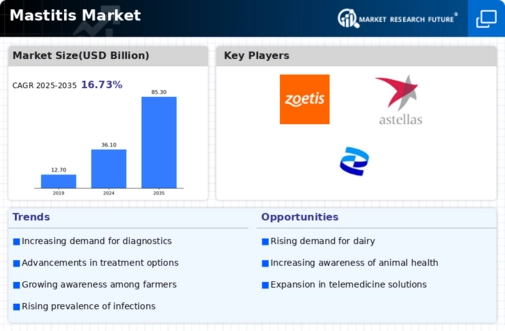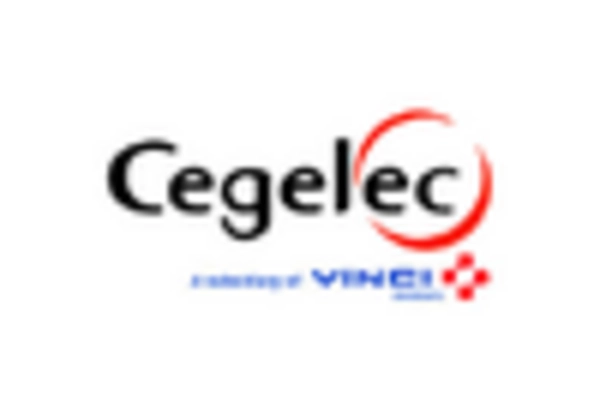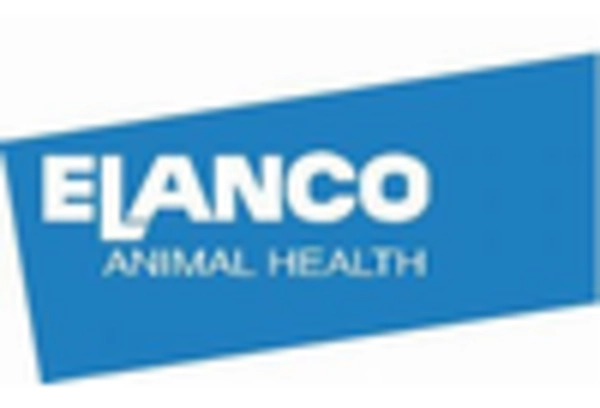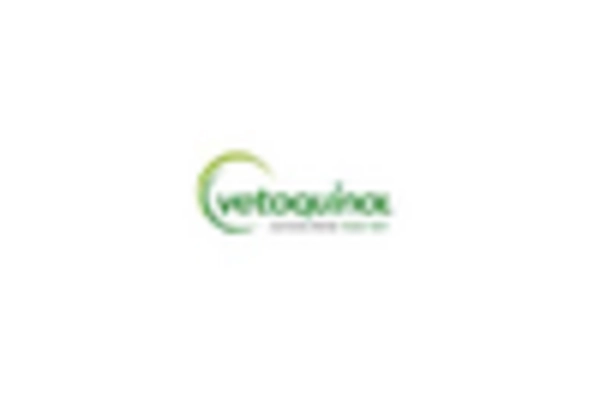-
Report Prologue
-
Market Introduction
-
Definition 19
-
Scope of the Study 19
-
Research Objective 19
-
Assumptions & Limitations 19
- Assumptions 19
- Limitations 19
- Market Structure 20
-
Research Methodology
-
Primary Research Methodology 22
-
Secondary Research Methodology 24
-
Market Size Estimation 25
-
Forecast Model 25
-
Market Dynamics
-
Introduction 27
-
Drivers 28
- Rising Cases of Breast Cancer 28
- Increasing Rate of Pregnancy 28
- Unhygienic Barn Conditions Causing Contagious Mastitis in Bovines 28
-
Restraints 29
- Lack of Awareness 29
- Complications in Diagnosis due to Similar Symptoms of Breast Cancer & Mastitis 29
-
Opportunity 29
- Entering Developing Economies 29
-
Macroeconomics 29
- Trends in Mastitis 30
-
Market Factor Analysis
-
Porter’s Five Forces Model 32
- Bargaining Power of Suppliers 32
- Bargaining Power of Buyers 33
- Threat of New Entrants 33
- Threat of Substitutes 33
- Intensity of Rivalry 33
-
Value Chain Analysis 34
- R&D & Designing 34
- Manufacturing 34
- Distribution & Sales 34
- Post-Sales Services 34
-
Investment Opportunities 35
-
Price Analysis 35
-
Global Mastitis Market, By Type
-
Introduction 37
-
Bovine 38
- Contagious Mastitis 38
- Environmental Mastitis 39
- Opportunist Mastitis 39
-
Human 40
- Non-Infectious Mastitis 40
- Infectious Mastitis 41
-
Global Mastitis Market, By Treatment
-
Introduction 43
-
Bovine 44
- Antibiotics 44
- Vaccines 44
-
Human 45
- Pain Relievers 45
- Antibiotics 45
-
Global Mastitis Market, By End User
-
Introduction 47
-
Veterinary Centers 48
-
Hospital & Clinics 48
-
Global Mastitis Market, By Region
-
Introduction 50
-
Americas 51
- North America 54
- South America 60
-
Europe 62
- Western Europe 64
- Eastern Europe 79
-
Asia-Pacific 81
- Japan 83
- China 85
- India 87
- Australia 89
- South Korea 91
- Rest of Asia-Pacific 93
-
Middle East & Africa 95
- Saudi Arabia 97
- United Arab Emirates 99
- Kuwait 101
- Oman 103
- Qatar 105
- Rest of Middle East 107
-
Competitive Landscape
-
Competitive Scenario 110
- Introduction 110
-
Company Profiles
-
Bayer AG 113
- Company Overview 113
- Financial Overview 113
- Products Offering 114
- Key Developments 114
- SWOT Analysis 114
- Key Strategy 114
-
BioNumerik Pharmaceuticals Inc 115
- Company Overview 115
- Financial Overview 115
- Products/Services Offered 115
- Key Developments 115
- SWOT Analysis 116
- Key Strategy 116
-
Oncothyreon Inc 117
- Company Overview 117
- Financial Overview 117
- Products/Services Offered 117
- Key Developments 117
- SWOT Analysis 118
- Key Strategy 118
-
Oncogenex 119
- Company Overview 119
- Financial Overview 119
- Products/Services Offered 119
- Key Developments 119
- SWOT Analysis 119
- Key Strategy 120
-
Apthera Inc. 121
- Company Overview 121
- Financial Overview 121
- Products/Services Offered 121
- Key Developments 121
- SWOT Analysis 121
- Key Strategy 122
-
Zoetis Inc 123
- Company Overview 123
- Financial Overview 123
- Products/Services Offered 124
- Key Developments 124
- SWOT Analysis 124
- Key Strategy 124
-
Boehringer Ingelheim GmbH 125
- Company Overview 125
- Financial Overview 125
- Products/Services Offered 126
- Key Developments 126
- SWOT Analysis 126
- Key Strategy 126
-
Merck Co. & Inc 127
- Company Overview 127
- Financial Overview 127
- Products/Services Offered 128
- Key Developments 128
- SWOT Analysis 128
- Key Strategy 128
-
Astellas Pharma Inc 129
- Company Overview 129
- Financial Overview 129
- Products/Services Offered 130
- Key Developments 130
- SWOT Analysis 130
- Key Strategy 130
-
Pfizer Inc. 131
- Company Overview 131
- Financial Overview 131
- Products/Services Offered 132
- Key Developments 132
- SWOT Analysis 132
- Key Strategy 132
-
Novartis AG 133
- Company Overview 133
- Financial Overview 133
- Products/Services Offered 134
- Key Developments 134
- SWOT Analysis 134
- Key Strategy 134
-
Sanofi SA 135
- Company Overview 135
- Financial Overview 135
- Products/Services Offered 136
- Key Developments 136
- SWOT Analysis 136
- Key Strategy 136
-
F. Hoffmann-La Roche AG 137
- Company Overview 137
- Financial Overview 137
- Products/Services Offered 138
- Key Developments 138
- SWOT Analysis 138
- Key Strategy 138
-
Appendix
-
Discussion Blue Print 140
-
References 141
-
List of Tables
-
MARKET SYNOPSIS 17
-
PRIMARY INTERVIEWS 23
-
GLOBAL MASTITIS MARKET, BY TYPE 2020–2027 (USD MILLION) 37
-
GLOBAL MASTITIS MARKET FOR BOVINE, BY TYPE 2020–2027 (USD MILLION) 38
-
GLOBAL MASTITIS MARKET FOR BOVINE, BY REGION 2020–2027 (USD MILLION) 38
-
GLOBAL MASTITIS MARKET FOR CONTAGIOUS MASTITIS, BY REGION 2020–2027 (USD MILLION) 38
-
GLOBAL MASTITIS MARKET FOR ENVIRONMENTAL MASTITIS, BY REGION 2020–2027 (USD MILLION) 39
-
GLOBAL MASTITIS MARKET FOR OPPORTUNIST MASTITIS, BY REGION 2020–2027 (USD MILLION) 39
-
GLOBAL MASTITIS MARKET FOR HUMAN, BY TYPE 2020–2027 (USD MILLION) 40
-
GLOBAL MASTITIS MARKET FOR HUMAN, BY REGION 2020–2027 (USD MILLION) 40
-
GLOBAL MASTITIS MARKET FOR NON–INFECTIOUS MASTITIS, BY REGION 2020–2027 (USD MILLION) 40
-
GLOBAL MASTITIS MARKET FOR INFECTIOUS MASTITIS, BY REGION 2020–2027 (USD MILLION) 41
-
GLOBAL MASTITIS MARKET, BY TREATMENT 2020–2027 (USD MILLION) 43
-
GLOBAL MASTITIS MARKET FOR BOVINE, BY TREATMENT TYPE 2020–2027 (USD MILLION) 44
-
GLOBAL MASTITIS MARKET FOR ANTIBIOTICS, BY REGION TYPE 2020–2027 (USD MILLION) 44
-
GLOBAL MASTITIS MARKET FOR VACCINES, BY REGION 2020–2027 (USD MILLION) 44
-
GLOBAL MASTITIS MARKET FOR HUMAN, BY TREATMENT TYPE 2020–2027 (USD MILLION) 45
-
GLOBAL MASTITIS MARKET FOR PAIN RELIEVERS, BY REGION TYPE 2020–2027 (USD MILLION) 45
-
GLOBAL MASTITIS MARKET FOR ANTIBIOTICS, BY REGION 2020–2027 (USD MILLION) 45
-
GLOBAL MASTITIS MARKET, BY END–USER 2020–2027 (USD MILLION) 47
-
GLOBAL MASTITIS MARKET FOR VETERINARY CENTRES, BY REGION 2020–2027 (USD MILLION) 48
-
GLOBAL MASTITIS MARKET FOR HOSPITAL & CLINICS, BY REGION 2020–2027 (USD MILLION) 48
-
GLOBAL MASTITIS MARKET, BY REGION 2020–2027 (USD MILLION) 51
-
AMERICAS MASTITIS MARKET, BY REGION 2020–2027 (USD MILLION) 51
-
AMERICAS MASTITIS MARKET, BY TYPE 2020–2027 (USD MILLION) 52
-
AMERICAS MASTITIS MARKET FOR BOVINE, BY TYPE 2020–2027 (USD MILLION) 52
-
AMERICAS MASTITIS MARKET FOR HUMAN, BY TYPE 2020–2027 (USD MILLION) 52
-
AMERICAS MASTITIS MARKET, BY TREATMENT 2020–2027 (USD MILLION) 52
-
AMERICAS MASTITIS MARKET FOR BOVINE, BY TREATMENT TYPE 2020–2027 (USD MILLION) 53
-
AMERICAS MASTITIS MARKET FOR HUMAN, BY TREATMENT TYPE 2020–2027 (USD MILLION) 53
-
AMERICAS MASTITIS MARKET, BY END–USER 2020–2027 (USD MILLION) 53
-
NORTH AMERICA MASTITIS MARKET, BY COUNTRY 2020–2027 (USD MILLION) 54
-
NORTH AMERICA MASTITIS MARKET, BY TYPE 2020–2027 (USD MILLION) 54
-
NORTH AMERICA MASTITIS MARKET FOR BOVINE, BY TYPE 2020–2027 (USD MILLION) 54
-
NORTH AMERICA MASTITIS MARKET FOR HUMAN, BY TYPE 2020–2027 (USD MILLION) 55
-
NORTH AMERICA MASTITIS MARKET, BY TREATMENT 2020–2027 (USD MILLION) 55
-
NORTH AMERICA MASTITIS MARKET FOR BOVINE, BY TREATMENT TYPE 2020–2027 (USD MILLION) 55
-
NORTH AMERICA MASTITIS MARKET FOR HUMAN, BY TREATMENT TYPE 2020–2027 (USD MILLION) 55
-
NORTH AMERICA MASTITIS MARKET, BY END–USER 2020–2027 (USD MILLION) 56
-
US MASTITIS MARKET, BY TYPE 2020–2027 (USD MILLION) 56
-
US MASTITIS MARKET FOR BOVINE, BY TYPE 2020–2027 (USD MILLION) 56
-
US MASTITIS MARKET FOR HUMAN, BY TYPE 2020–2027 (USD MILLION) 56
-
US MASTITIS MARKET, BY TREATMENT 2020–2027 (USD MILLION) 57
-
US MASTITIS MARKET FOR BOVINE, BY TREATMENT TYPE 2020–2027 (USD MILLION) 57
-
US MASTITIS MARKET FOR HUMAN, BY TREATMENT TYPE 2020–2027 (USD MILLION) 57
-
US MASTITIS MARKET, BY END–USER 2020–2027 (USD MILLION) 57
-
CANADA MASTITIS MARKET, BY TYPE 2020–2027 (USD MILLION) 58
-
CANADA MASTITIS MARKET FOR BOVINE, BY TYPE 2020–2027 (USD MILLION) 58
-
CANADA MASTITIS MARKET FOR HUMAN, BY TYPE 2020–2027 (USD MILLION) 58
-
CANADA MASTITIS MARKET, BY TREATMENT 2020–2027 (USD MILLION) 58
-
CANADA MASTITIS MARKET FOR BOVINE, BY TREATMENT TYPE 2020–2027 (USD MILLION) 59
-
CANADA MASTITIS MARKET FOR HUMAN, BY TREATMENT TYPE 2020–2027 (USD MILLION) 59
-
CANADA MASTITIS MARKET, BY END–USER 2020–2027 (USD MILLION) 59
-
SOUTH AMERICA MASTITIS MARKET, BY TYPE 2020–2027 (USD MILLION) 60
-
SOUTH AMERICA MASTITIS MARKET FOR BOVINE, BY TYPE 2020–2027 (USD MILLION) 60
-
SOUTH AMERICA MASTITIS MARKET FOR HUMAN, BY TYPE 2020–2027 (USD MILLION) 60
-
SOUTH AMERICA MASTITIS MARKET, BY TREATMENT 2020–2027 (USD MILLION) 60
-
SOUTH AMERICA MASTITIS MARKET FOR BOVINE, BY TREATMENT TYPE 2020–2027 (USD MILLION) 61
-
SOUTH AMERICA MASTITIS MARKET FOR HUMAN, BY TREATMENT TYPE 2020–2027 (USD MILLION) 61
-
SOUTH AMERICA MASTITIS MARKET, BY END–USER 2020–2027 (USD MILLION) 61
-
EUROPE MASTITIS MARKET, BY REGION 2020–2027 (USD MILLION) 62
-
EUROPE MASTITIS MARKET, BY TYPE 2020–2027 (USD MILLION) 62
-
EUROPE MASTITIS MARKET FOR BOVINE, BY TYPE 2020–2027 (USD MILLION) 62
-
EUROPE MASTITIS MARKET FOR HUMAN, BY TYPE 2020–2027 (USD MILLION) 63
-
EUROPE MASTITIS MARKET, BY TREATMENT 2020–2027 (USD MILLION) 63
-
EUROPE MASTITIS MARKET FOR BOVINE, BY TREATMENT TYPE 2020–2027 (USD MILLION) 63
-
EUROPE MASTITIS MARKET FOR HUMAN, BY TREATMENT TYPE 2020–2027 (USD MILLION) 63
-
EUROPE MASTITIS MARKET, BY END–USER 2020–2027 (USD MILLION) 64
-
WESTERN EUROPE MASTITIS MARKET, BY COUNTRY 2020–2027 (USD MILLION) 64
-
WESTERN EUROPE MASTITIS MARKET, BY TYPE 2020–2027 (USD MILLION) 65
-
WESTERN EUROPE MASTITIS MARKET FOR BOVINE, BY TYPE 2020–2027 (USD MILLION) 65
-
WESTERN EUROPE MASTITIS MARKET FOR HUMAN, BY TYPE 2020–2027 (USD MILLION) 65
-
WESTERN EUROPE MASTITIS MARKET, BY TREATMENT 2020–2027 (USD MILLION) 65
-
WESTERN EUROPE MASTITIS MARKET FOR BOVINE, BY TREATMENT TYPE 2020–2027 (USD MILLION) 66
-
WESTERN EUROPE MASTITIS MARKET FOR HUMAN, BY TREATMENT TYPE 2020–2027 (USD MILLION) 66
-
WESTERN EUROPE MASTITIS MARKET, BY END–USER 2020–2027 (USD MILLION) 66
-
GERMANY MASTITIS MARKET, BY TYPE 2020–2027 (USD MILLION) 67
-
GERMANY MASTITIS MARKET FOR BOVINE, BY TYPE 2020–2027 (USD MILLION) 67
-
GERMANY MASTITIS MARKET FOR HUMAN, BY TYPE 2020–2027 (USD MILLION) 67
-
GERMANY MASTITIS MARKET, BY TREATMENT 2020–2027 (USD MILLION) 67
-
GERMANY MASTITIS MARKET FOR BOVINE, BY TREATMENT TYPE 2020–2027 (USD MILLION) 68
-
GERMANY MASTITIS MARKET FOR HUMAN, BY TREATMENT TYPE 2020–2027 (USD MILLION) 68
-
GERMANY MASTITIS MARKET, BY END–USER 2020–2027 (USD MILLION) 68
-
FRANCE MASTITIS MARKET, BY TYPE 2020–2027 (USD MILLION) 69
-
FRANCE MASTITIS MARKET FOR BOVINE, BY TYPE 2020–2027 (USD MILLION) 69
-
FRANCE MASTITIS MARKET FOR HUMAN, BY TYPE 2020–2027 (USD MILLION) 69
-
FRANCE MASTITIS MARKET, BY TREATMENT 2020–2027 (USD MILLION) 69
-
FRANCE MASTITIS MARKET FOR BOVINE, BY TREATMENT TYPE 2020–2027 (USD MILLION) 70
-
FRANCE MASTITIS MARKET FOR HUMAN, BY TREATMENT TYPE 2020–2027 (USD MILLION) 70
-
FRANCE MASTITIS MARKET, BY END–USER 2020–2027 (USD MILLION) 70
-
UK MASTITIS MARKET, BY TYPE 2020–2027 (USD MILLION) 71
-
UK MASTITIS MARKET FOR BOVINE, BY TYPE 2020–2027 (USD MILLION) 71
-
UK MASTITIS MARKET FOR HUMAN, BY TYPE 2020&
-
'









Leave a Comment